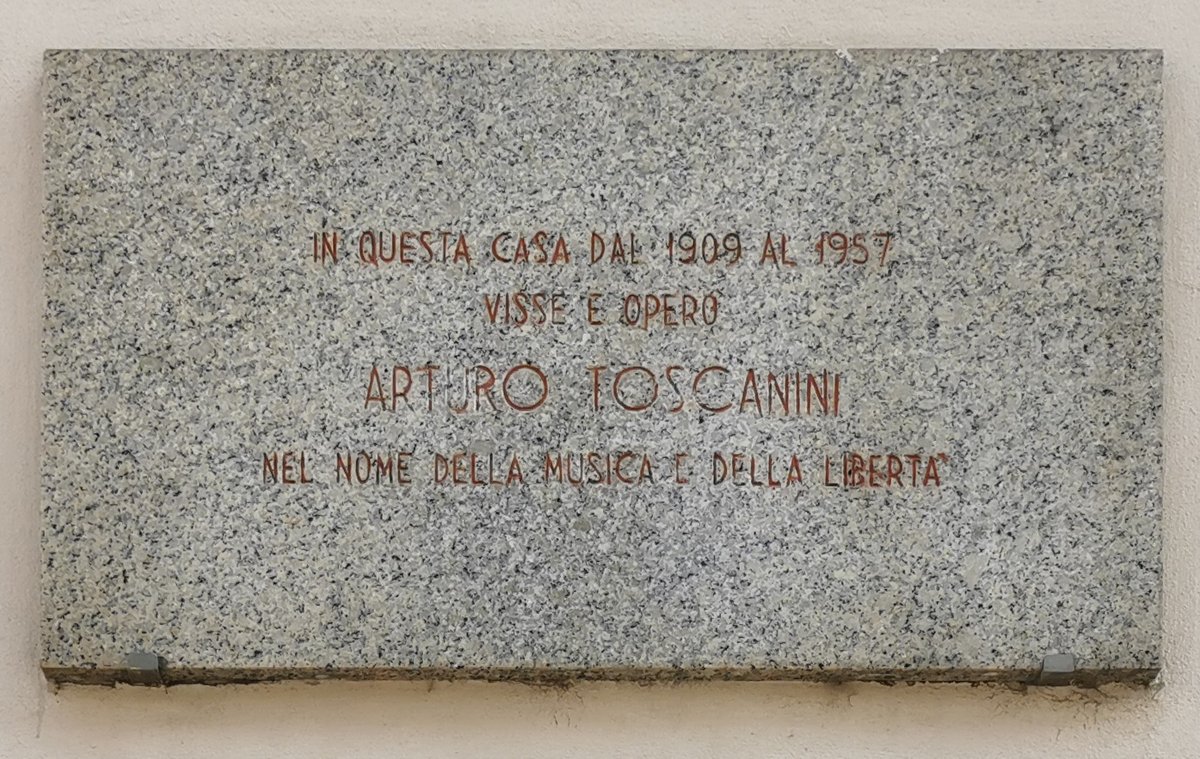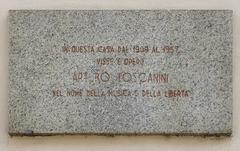
Casa Toscanini Milan: Visiting Hours, Tickets, and Historical Sites Guide
Date: 15/06/2025
Introduction: Casa Toscanini’s History and Cultural Significance
Casa Toscanini, located in the heart of Milan, is a distinguished cultural and historical landmark intricately tied to the city’s illustrious musical heritage and architectural tradition. This early 20th-century residence was the long-time home of Arturo Toscanini, one of the most influential conductors of his era. His visionary leadership helped shape Milan’s operatic legacy, particularly through his work at Teatro alla Scala. More than just a private residence, Casa Toscanini was a vibrant hub for artistic and intellectual exchange, hosting prominent musicians, composers, and cultural figures who contributed to Milan’s reputation as a European capital of the arts (Milano Explorer; milanoxnoi.it).
Architecturally, Casa Toscanini stands out for its late Baroque influences, particularly its rusticated stonework portal and the unique Andalusian-style wrought iron balcony, which reflect the cosmopolitan spirit of Milan’s artistic exchanges (it.wikipedia.org). The building offers a rare opportunity to experience the lifestyle and ambiance of Milanese patrician residences from the 18th and early 20th centuries, well-preserved amid the city’s changing urban landscape.
With its central location—just a short walk from landmarks like Teatro alla Scala, the Pinacoteca di Brera, and Via Montenapoleone—Casa Toscanini is an essential cultural stop for visitors exploring Milan’s vibrant city center (yesmilano.it; Savoring Italy). This guide is designed to provide a comprehensive overview of Casa Toscanini’s historical, cultural, and architectural importance, as well as practical details to ensure an enriching visit.
Table of Contents
- Origins and Architectural Context
- Historical Residents and Cultural Legacy
- Milanese Villas and Palaces: Casa Toscanini’s Place in History
- Preservation and Commemoration
- Milan’s Musical Heritage and Toscanini’s Legacy
- Architectural and Artistic Highlights
- Visiting Casa Toscanini: Hours, Tickets, and Access
- Directions and Transport
- Nearby Attractions
- Visitor FAQs
- Visuals and Media
- Further Resources and External Links
- Summary and Recommendations
Origins and Architectural Context
Casa Toscanini, situated at Via Durini 20, exemplifies Milan’s tradition of patrician residences. The three-story structure dates back to the 18th century and reflects the era’s penchant for “villas of delight” (ville di delizia), built by the city’s elite to demonstrate their status and embrace the pleasures of refined urban living (it.wikipedia.org). Its late Baroque style is evident in the harmonious façade and decorative flourishes.
A defining feature of the building is its strombato (splayed) rusticated stone portal, signaling its historic pedigree. Above, the rare Andalusian-style wrought iron balcony—unusual for northern Italy—serves both a decorative and functional purpose, harkening to southern Spanish influences. The balcony’s intricate ironwork is mirrored in the entrance gate, creating a cohesive decorative ensemble.
Crossing the entrance, visitors discover a small Baroque courtyard, typical of Milanese palazzi, which offered residents a private retreat and a venue for social gatherings.
Historical Residents and Cultural Legacy
Arturo Toscanini, who resided here from 1909 until his death in 1957, elevated the house’s status to that of a cultural landmark (milanoxnoi.it). Toscanini’s tenure coincided with pivotal moments in Italian music, including the reopening of Teatro alla Scala in 1946—a symbol of cultural rebirth after World War II.
Casa Toscanini also welcomed other notable residents, such as philanthropist Virgilio Floriani, founder of the Fondazione Floriani, adding to its legacy as a center for cultural and social engagement (it.wikipedia.org).
Milanese Villas and Palaces: Casa Toscanini’s Place in History
Unlike other Italian cities with royal courts, Milan’s urban development was shaped by patrician and bourgeois commissions, resulting in residences that combined artistic innovation with social prestige (wikipedia.org). Many original villas have been lost to redevelopment, making Casa Toscanini an invaluable survivor that offers insight into the city’s 18th-century urban fabric.
The building’s Andalusian balcony exemplifies the cosmopolitan influences that shaped Milanese architecture, with artisans from across Italy and beyond contributing to the city’s unique palatial style.
Preservation and Commemoration
Casa Toscanini’s historical importance is marked by commemorative plaques on its façade, honoring both Toscanini and Floriani (it.wikipedia.org). Despite Milan’s history of urban renewal and wartime destruction, Casa Toscanini has retained its original character, including the Baroque courtyard and Andalusian balcony (wikipedia.org).
Milan’s Musical Heritage and Toscanini’s Legacy
Toscanini’s association with Casa Toscanini places it at the heart of Milan’s musical heritage. His influence extended well beyond the city, but Milan’s identity as a “sound city” is inextricably linked to his legacy and to the enduring importance of opera and classical music (yesmilano.it). The house remains a testament to this tradition, being steps away from Teatro alla Scala and other key institutions.
Architectural and Artistic Highlights
The artistry of Casa Toscanini is found in its harmonious façade, ornate iron balconies, and the Baroque courtyard. Inside, period features such as parquet flooring, ceiling moldings, and stained glass windows reflect early 20th-century tastes. Musical motifs—lyres, sheet music patterns, portraits, and memorabilia—pay tribute to Toscanini’s influence (Casa Toscanini - Zerodelta). Ongoing restoration ensures these elements are preserved for future generations.
Visiting Casa Toscanini: Hours, Tickets, and Access
- Opening Hours: Tuesday–Sunday, 10:00 AM–6:00 PM (last admission 5:30 PM). Closed Mondays and public holidays. Check the official website for updates.
- Tickets: General admission €12; reduced €8 (students, seniors); children under 12 free. Tickets are available online or at the entrance—advance booking is recommended.
- Guided Tours: Available in Italian, English, and French. Book in advance, especially during peak seasons.
- Accessibility: The building is partially accessible; contact the visitor center for specific needs.
- Photography: Permitted in designated areas without flash or tripods.
Directions and Transport
- Metro: Montenapoleone (Line 3, Yellow), 5 minutes on foot.
- Bus: Lines 61 and 94 stop nearby.
- On Foot: Close to Teatro alla Scala and other major attractions.
Drivers should note that central Milan parking is limited and can be expensive, so public transport is recommended (Savoring Italy).
Nearby Attractions
Enhance your cultural itinerary with these nearby sites:
- Teatro alla Scala: Legendary opera house.
- Pinacoteca di Brera: Premier art gallery with Renaissance masterpieces.
- Via Montenapoleone: Milan’s luxury shopping street.
- Duomo di Milano: Iconic Gothic cathedral.
Visitor FAQs
Q: What are the visiting hours?
A: Tuesday–Sunday, 10:00 AM–6:00 PM; closed Mondays and public holidays.
Q: How much are tickets?
A: Adults €12; students and seniors €8; children under 12 free.
Q: Are guided tours available?
A: Yes, in multiple languages. Advance booking is recommended.
Q: Is the building accessible?
A: Partial accessibility—contact in advance for details.
Q: Can I take photos?
A: Yes, in select areas, without flash or tripods.
Visuals and Media
Discover Casa Toscanini’s façade, Andalusian balcony, and Baroque courtyard online. Virtual tours and interactive maps help plan your visit.
Further Resources and External Links
- Official Casa Toscanini Website
- Visit Milan Tourism
- Milano Explorer: Top Historical Sites
- Casa Toscanini - Zerodelta
- Savoring Italy: Travel to Milan
- Villas and Palaces in Milan - Wikipedia
- TravelDIR: Milan Monthly Guide
- Milano Segreta: Cultural Sites
Summary and Visitor Recommendations
Casa Toscanini stands as a vital testament to Milan’s musical and cultural legacy. It embodies the city’s artistic spirit through its association with Arturo Toscanini and its well-preserved architecture, including the rare Andalusian balcony and Baroque courtyard (it.wikipedia.org; wikipedia.org). As a hub for music history and cultural tourism, it continues to inspire through exhibitions, educational programs, and special events (Milano Segreta; Milano Explorer).
For the best experience:
- Book tickets and guided tours in advance.
- Check accessibility options if needed.
- Combine your visit with nearby landmarks for a comprehensive Milan itinerary.
Stay updated by visiting the official Casa Toscanini website and YesMilano, and consider downloading the Audiala app for audio guides and event updates. Immerse yourself in the intersection of history, music, and architecture at one of Milan’s most emblematic sites.






























































